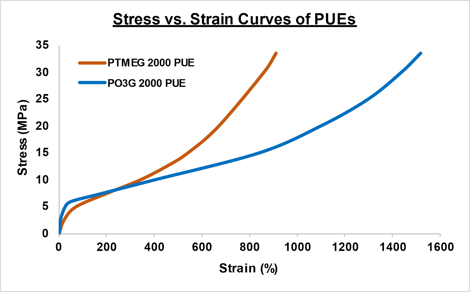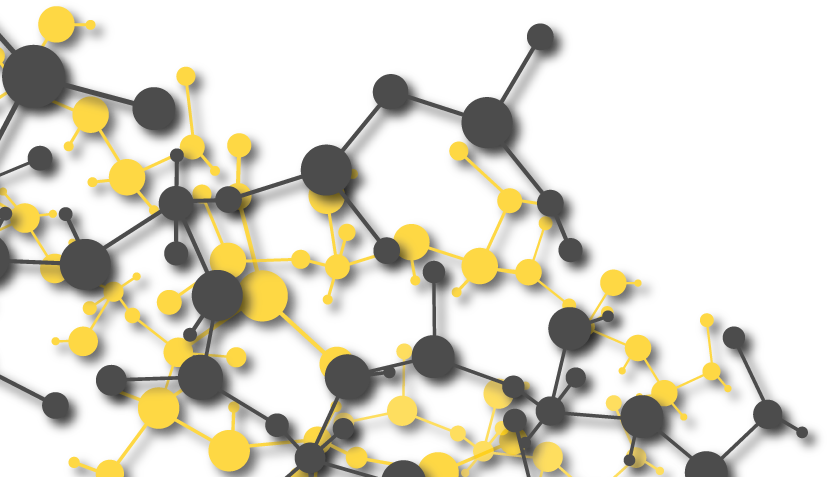Gantrade’s poly(trimethylene ether) glycols (PO3G) are 100% bio-based, linear high-performance liquid polyether polyols. This series of 100% sustainable content polyether polyols was commercialized by SK Chemicals in a newly completed production facility in Ulsan, South Korea. Introduced under the trade name ECOTRION, PO3G is derived from bio-based 1,3-propanediol, obtained through fermentation of industrial (non-food) corn. A ISO 14000 compliant life cycle analysis found that PO3G offers a lower environmental footprint including a 45% reduction in greenhouse gas emissions.

Poly(trimethylene ether) glycols are liquid difunctional polyols, low in toxicity, and easily processed. In polyurethanes, they exhibit good hydrolytic stability in wet environments, low temperature flexibility, excellent toughness and abrasion resistance, excellent flex fatigue life, durability, and good elastic recovery and resiliency. The PO3G series combines high tensile strengths and high elongations in the same polyurethane elastomer.
Bio-based poly(trimethylene ether) glycol compliments Gantrade’s strong global position in the homologous poly(tetramethylene ether) glycol (PTMEG) series. PO3G allows the introduction of bio based technology into the high-performance segment of the polyurethanes industry. Gantrade can assist our customers in meeting their efforts to build a “green” polyurethane platform.
PO3G Attributes in Urethane Elastomers
In polyurethane elastomers, PO3G exhibits performance comparable to PTMEG-based polyurethanes and polyurea elastomers. PO3G provides performance benefits in all MDI-based, TDI-based, and aliphatic isocyanate elastomers. The following performance attributes are exhibited by PO3G in polyurethanes and polyureas:
- 100% bio-based soft segment
- Superior resistance to hydrolytic cleavage
- Exceptional flexibility and property retention at low temperatures
- High resiliency and rebound properties
- Excellent mechanical & dynamic properties and low hysteresis
- High abrasion resistance
- Good cut, chip, and tear resistance
- Lower propensity to cold-harden
PO3G diol has one less methylene unit vs. the homologous PTMEG diols. This imparts many improved handling and processing characteristics, as follows:
- PO3G polyols are liquids at room temperature
- Produced with low molecular weight distributions affording lower viscosities, Mw/Mn ~1.5-1.7
- Prepolymers remain liquid with low viscosity characteristics
- Good polyol and prepolymer compatibility with chain extenders and curatives
- Like PTMEG polyols, they have exact di-functionality and exhibit excellent reactivity with isocyanates
- PO3G MDI and TDI prepolymers are lower in viscosity and more easily processed
- Excellent prepolymer storage stability
PO3G Specifications
Our poly(trimethylene ether) glycols are available in two molecular weight grades, H1000 and H2000. They are based on 100% sustainable content.
|
ECOTRION |
Molecular Weight |
Hydroxyl No, mgKOH/g |
Alkalinity, mgKOH/g |
Color, APHA |
Viscosity, cps@ 25 °C |
Moisture ppm |
Tg, °C |
Tm, °C |
|
H1000 |
900-1100 |
102-124.7 |
-2.0 ~ +2.0 |
<50 |
400-600 |
<200 |
-71 |
13 |
|
H2000 |
1900-2100 |
53.4-59.1 |
-2.0 ~ +2.0 |
<50 |
1700-1900 |
<200 |
-75 |
17 |
Applications of PO3G: High Performance Renewable Polyol
PO3G allows the introduction of renewable, “green” polyols into the high-performance application segments of the polyurethane and polyurea industries. The linear, symmetrical, and exact di-functional nature of these polyols contribute to the enhanced property levels required in demanding polyurethane elastomer application segments.
Applications where PO3G provides benefits include:
- Cast elastomers
- Thermoplastic Polyurethanes (TPUs)
- Coatings, including waterborne polyurethane dispersions (PURs)
- Adhesives and Sealants
- Foam Technologies
- Elastic Fiber
- 3D Printing
Examples of end-use markets include the following.
- High load wheels and rollers such as skate and amusement park wheels
- Mining and oil field equipment
- Coatings for synthetic leather and textiles used in automotive and furniture
- Adhesives, sealants, and binders
- Sport shoes and waterproof, breathable textiles
- Synthetic leather goods
Elastic Properties of Polyether Polyurethanes
The effects of elastic deformation on MDI-Butanediol-based systems are revealing, regarding the microphase structures of PTMEG 2000 and PO3G 2000 soft segments (prepolymer route).
The stress-strain curves for these two polyurethanes are shown in the chart right. Notable is the strong strain induced crystallization behavior of the PTMEG based PUR reflected in the steeper slope of the stress-strain curve as crystallization occurs. Elongation at break occurs at about 920% for the PTMEG-PUR. In contrast, the PO3G 2000 PUR exhibits a weaker strain induced crystallization response in the soft-block segment under elastic deformation.

Reference: Fei Ping, et. al., Polymer, 239, (2022) 124429.
The elongation at break of the PO3G PUR occurs at ~1500%, which is 63% higher than the value of the PTMEG 2000 PUR. The results are attributed to the odd number of methylene groups in the repeating unit of the PO3G soft segment.
An even number of methylene groups, as in the PTMEG soft segment, improves the packing of the chains in the crystal structure and enhances strain induced crystallization. The odd-number of methylene groups in the PO3G reduces crystallinity, contributing to high elongations, lower viscosities, increased abrasion resistance and a reduced propensity to cold-harden.
Properties of PO3G Polyurethanes
The tables below show the properties of the H-1000 and H-2000 polyols in TDI/amine curative systems and an MDI/BDO system. All PO3G elastomers exhibited excellent mechanical properties. A distinction of the PO3G elastomers is that they combine high tensile strengths and high elongations in the same elastomer. The information is based on the work of Chuck Demarest and presented at the 2010 Polyurethane Manufacturers Associations Annual Conference in 2010.
The polyureas below were prepared from PO3G/TDI prepolymers and cured with MOCA or MCDEA. All elastomers were tough, exhibited high elongations, excellent ball rebound values and good compression set and abrasion resistance.
PO3G/TDI Prepolymers Cured with MOCA and MCDEA: Polyurethane Properties
|
H-1000 |
H-2000 |
H-2000 |
|
|
Curative |
MOCA |
MOCA |
MCDEA |
|
NCO, % |
6.18 |
3.58 |
3.40 |
|
Soft Segment, % |
62.5 |
75 |
74.5 |
|
Hardness, Shore A |
94 |
87 |
90 |
|
100% Modulus 300% Modulus |
2339 3458 |
1080 1620 |
1372 2025 |
|
Tensile Strength, psi |
6271 |
4051 |
3448 |
|
Elongation, % |
475 |
650 |
510 |
|
Split Tear, pli |
255 |
130 |
116 |
|
Die C Tear, pli |
468 |
307 |
333 |
|
Ball Rebound, % |
54 |
70 |
69 |
|
Compression Set, % |
29 |
26 |
32 |
|
Tabor Abrasion, mg. loss |
87 |
32 |
75 |
Cast Elastomer Properties for PO3G/MDI Prepolymers Chain Extended with 1,4-Butanediol (BDO)
Compared with the TDI systems, the MDI-based elastomers are softer, more flexible materials with excellent abrasion resistance and high ball rebound values.
|
H-2000 |
H-2000 |
|
|
NCO, % |
3.31 |
5.10 |
|
Soft Segment, % |
72 |
78 |
|
Hardness, Shore A |
67 |
77 |
|
100% Modulus |
417 |
741 |
|
300% Modulus |
767 |
1246 |
|
Tensile Strength, psi |
2600 |
4715 |
|
Elongation, % |
675 |
850 |
|
Split Tear, pli |
55 |
125 |
|
Die C Tear, pli |
165 |
323 |
|
Ball Rebound, % |
75 |
76 |
|
Compression Set, % |
34 |
25 |
|
Tabor Abrasion, mg. loss |
11 |
19 |
The PO3G based polyurethanes are very well suited to the more demanding applications found in the high-performance segments of the elastomers industry.
Safety and Handling
PO3G polyols are non-hazardous, stable products with a low order of toxicity. Toxicological testing indicates PO3G is a non-irritant to both skin and eyes. PO3G is stable under proper storage and handling conditions and possesses a high flashpoint. Therefore, minimum fire hazards exist under normal storage conditions.
Gantrade Corporation encourages its customers to have a comprehensive understanding of the health, safety, environmental and regulatory information on its products before handling and disposal. To obtain a Safety Data Sheet (SDS) and other handling information, please contact us. Always prevent electrostatic discharge and ensure adequate ventilation in the work and storage areas.
Gantrade: Leading Supplier for Bio-Based Polyols
Poly(trimethylene ether) glycol PO3G allows the introduction of bio-based, sustainable technology into the high performance segment of the polyurethane elastomers industry. They are liquid polyols, low in toxicity and easily processed. PO3G based polyurethanes exhibit the attributes assigned to the homologous PTMEG polyol series, such as good hydrolytic stability in wet environments, low temperature flexibility, excellent toughness and abrasion resistance, excellent flex fatigue life, durability, and good elastic recovery. In addition, the PO3G series polyurethanes combine high tensile strengths and high elongations in the same elastomer.
To explore which polyol is best suited for your unique needs, partner with Gantrade. We are a global leader in the distribution of high-performance polyols for a variety of performance enhancements within multiple industry applications. Our team’s wealth of technical knowledge and expertise, along with our uncompromising standards for customer service, ensure that you will receive the best polyurethane solutions for applications.
Gantrade’s urethane platform of specialty polyols, chain extenders, and curatives provide a broad range of possibilities to achieve your high-performance polyurethane requirements. Our global supply chain means high-quality chemical products where you need them when you need them. Contact Gantrade today to learn more.














